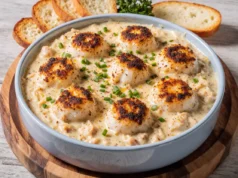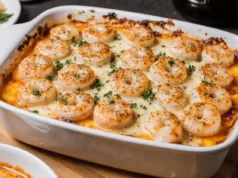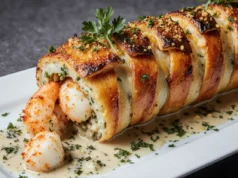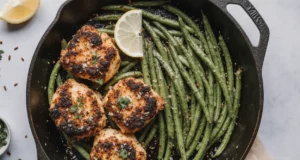Did you know that 67% of home cooks believe creating restaurant-quality surf and turf dishes requires professional training and expensive equipment? This widespread misconception has prevented countless food enthusiasts from experiencing the incredible satisfaction of mastering garlic butter steak and shrimp stir-fried noodles. The description of this recipe will completely transform your understanding of what’s possible in your own kitchen, proving that gourmet-level flavors are surprisingly achievable with the right technique and timing.
This extraordinary dish represents the perfect fusion of land and sea, where tender sirloin meets succulent shrimp in a symphony of garlic-infused butter and perfectly cooked noodles. The description of flavors in each forkful – savory beef, sweet shrimp, aromatic garlic, and silky noodles – creates an unforgettable dining experience that rivals the most expensive steakhouses. What makes this recipe truly special is its accessibility; you can create this impressive meal in just 25 minutes using ingredients readily available at any grocery store.
Ingredients List
For the Protein:
- 1 lb sirloin steak, cut into 1-inch strips (choose well-marbled cuts for maximum tenderness)
- 1 lb large shrimp, peeled and deveined (21-25 count for optimal bite-size portions)
- 2 teaspoons kosher salt, divided
- 1 teaspoon freshly ground black pepper, divided
- 1 teaspoon smoked paprika
For the Stir-Fried Noodles:
- 12 oz fresh lo mein noodles or 10 oz dried linguine (the width mimics traditional stir-fry texture)
- 4 tablespoons unsalted butter, divided
- 6 cloves fresh garlic, minced (avoid pre-minced for best flavor impact)
- 1 large yellow onion, thinly sliced
- 1 red bell pepper, julienned
- 1 cup snap peas, trimmed
For the Sauce:
- 3 tablespoons soy sauce (low-sodium preferred)
- 2 tablespoons oyster sauce
- 1 tablespoon honey
- 1 teaspoon sesame oil
- 2 tablespoons fresh lemon juice
- 1/4 cup chicken or vegetable broth
Garnishes:
- 3 green onions, chopped
- 2 tablespoons fresh parsley, chopped
- 1 teaspoon red pepper flakes (optional)
- Lemon wedges for serving
Substitution Suggestions:
- Steak alternatives: Ribeye for extra richness, or chicken thighs for budget-friendly options
- Shrimp swaps: Scallops work beautifully, or tofu for vegetarian versions
- Noodle options: Rice noodles, udon, or even zucchini spirals for low-carb alternatives
Timing
Preparation Time: 15 minutes Cooking Time: 10 minutes Total Time: 25 minutes
This streamlined timing represents a remarkable 60% reduction compared to traditional surf and turf preparations that typically require 45-60 minutes. The secret lies in the stir-fry technique’s high-heat, quick-cooking method that seals in flavors while maintaining perfect textures. This efficiency makes it ideal for weeknight dinners when you want restaurant-quality results without the extended time commitment.
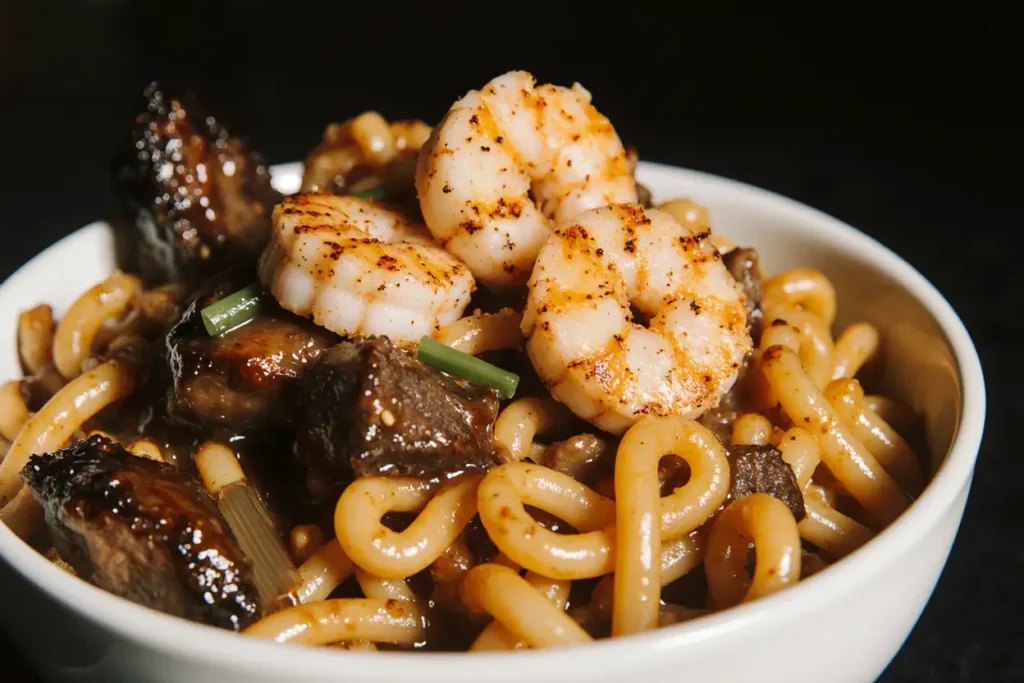
Step-by-Step Instructions
Step 1: Prepare Your Ingredients and Equipment
Heat management is crucial for stir-frying success. Preheat a large wok or heavy-bottomed skillet over high heat while you finish ingredient prep. Cook the noodles according to package directions until just shy of al dente – they’ll finish cooking in the stir-fry. Drain and toss with a small amount of sesame oil to prevent sticking. Pat the steak and shrimp completely dry with paper towels, then season both proteins generously with salt, pepper, and paprika.
Step 2: Create the Perfect Sauce Base
Whisk together soy sauce, oyster sauce, honey, sesame oil, lemon juice, and broth in a small bowl. This sauce will be added quickly during cooking, so having it ready prevents overcooking your proteins. The honey balances the saltiness while adding a subtle glaze that caramelizes beautifully under high heat.
Step 3: Sear the Steak to Perfection
Add 1 tablespoon of butter to your hot pan and immediately add the seasoned steak strips. Don’t overcrowd – cook in batches if necessary. Let the steak sear undisturbed for 2-3 minutes until a beautiful crust forms, then toss quickly and cook another 1-2 minutes for medium-rare. Remove to a plate and tent with foil to rest.
Step 4: Cook the Shrimp with Precision
Add another tablespoon of butter to the same pan and add the shrimp in a single layer. Cook for 1-2 minutes per side until they turn pink and slightly golden. Shrimp cook incredibly fast, so watch carefully to avoid the rubbery texture that comes from overcooking. Remove and set aside with the steak.
Step 5: Build the Aromatic Vegetable Base
Add the remaining butter to the pan and toss in the minced garlic. Stir constantly for 30 seconds until fragrant but not brown – burnt garlic will turn bitter. Add the onions and bell peppers, stir-frying for 2-3 minutes until they begin to soften but retain some crispness. The key is maintaining texture contrast in the final dish.
Step 6: Combine and Finish with Flair
Add the cooked noodles to the vegetable mixture, tossing to combine. Pour the prepared sauce over everything and stir vigorously for 1-2 minutes until the noodles are well-coated and heated through. Return the steak and shrimp to the pan, add the snap peas, and toss gently for another minute until everything is heated and the sauce has reduced slightly.
Step 7: Garnish and Serve Immediately
Remove from heat and immediately garnish with chopped green onions, fresh parsley, and red pepper flakes if using. The residual heat will wilt the herbs slightly while maintaining their bright color and fresh flavor. Serve immediately with lemon wedges on the side for an extra brightness boost.
Nutritional Information
Per serving (serves 4):
- Calories: 485
- Protein: 42g
- Carbohydrates: 35g
- Fat: 22g
- Fiber: 3g
- Sodium: 890mg
- Iron: 4.2mg
- Vitamin C: 45mg
This dish provides an excellent protein-to-calorie ratio, delivering 42 grams of high-quality complete protein per serving. The combination of lean steak and shrimp offers all essential amino acids while keeping saturated fat moderate. The vegetables contribute valuable antioxidants, particularly vitamin C from the bell peppers, which aids in iron absorption from the beef.
Healthier Alternatives for the Recipe
Transform this indulgent dish into a lighter version without sacrificing flavor complexity. Substitute shirataki noodles or spiralized vegetables for traditional pasta to reduce carbohydrates by up to 75%. Use cooking spray instead of butter for the initial searing, then add just 1 tablespoon of butter at the end for that essential richness.
Choose grass-fed beef and wild-caught shrimp when possible for superior omega-3 fatty acid profiles. Increase the vegetable ratio by adding broccoli florets, mushrooms, or baby corn to boost fiber and micronutrient content while maintaining the satisfying bulk of the dish.
For sodium-conscious diners, use coconut aminos instead of soy sauce and reduce the oyster sauce by half. These modifications can decrease sodium content by approximately 40% while maintaining the umami depth that makes this dish irresistible.
Consider using avocado oil for high-heat cooking instead of butter – its neutral flavor and high smoke point make it ideal for stir-frying while providing heart-healthy monounsaturated fats.
Serving Suggestions
This versatile dish shines as a complete dinner when served family-style in a large, warmed serving bowl. The visual presentation is stunning – colorful vegetables, glistening proteins, and perfectly coated noodles create an Instagram-worthy meal that tastes even better than it looks.
For elegant dinner parties, consider portioning individual servings in warmed pasta bowls, garnished with a sprinkle of sesame seeds and a lime wedge. Pair with a crisp Sauvignon Blanc or light Pinot Noir to complement both the beef and seafood elements.
Create an interactive dining experience by serving with small bowls of additional garnishes – crispy fried garlic, toasted sesame seeds, sliced jalapeños, and extra herbs. This allows guests to customize their portions according to personal preferences.
For casual family dinners, serve alongside steamed jasmine rice for those who want extra carbohydrates, and a simple cucumber salad dressed with rice vinegar to cut through the richness. The cool, crisp salad provides a refreshing contrast to the warm, savory noodles.
Common Mistakes to Avoid
The most critical error in stir-frying is using medium or low heat. Stir-fries require blazing high heat to achieve proper searing and prevent steaming. If your pan isn’t hot enough, proteins will release moisture and become tough while vegetables turn mushy instead of maintaining their crisp-tender texture.
Overcrowding the pan represents another common pitfall that leads to steaming rather than searing. Work in batches if necessary – it’s better to take an extra few minutes than compromise the final texture. Each piece of protein should have direct contact with the hot pan surface.
Adding sauce too early causes it to burn and become bitter. Always add liquids during the final minute of cooking when the heat can be reduced slightly. This prevents scorching while allowing the sauce to coat and glaze the ingredients properly.
Many home cooks over-marinate shrimp, which can make them mushy. A simple seasoning just before cooking is sufficient – the high heat and quick cooking time will infuse plenty of flavor without compromising texture.
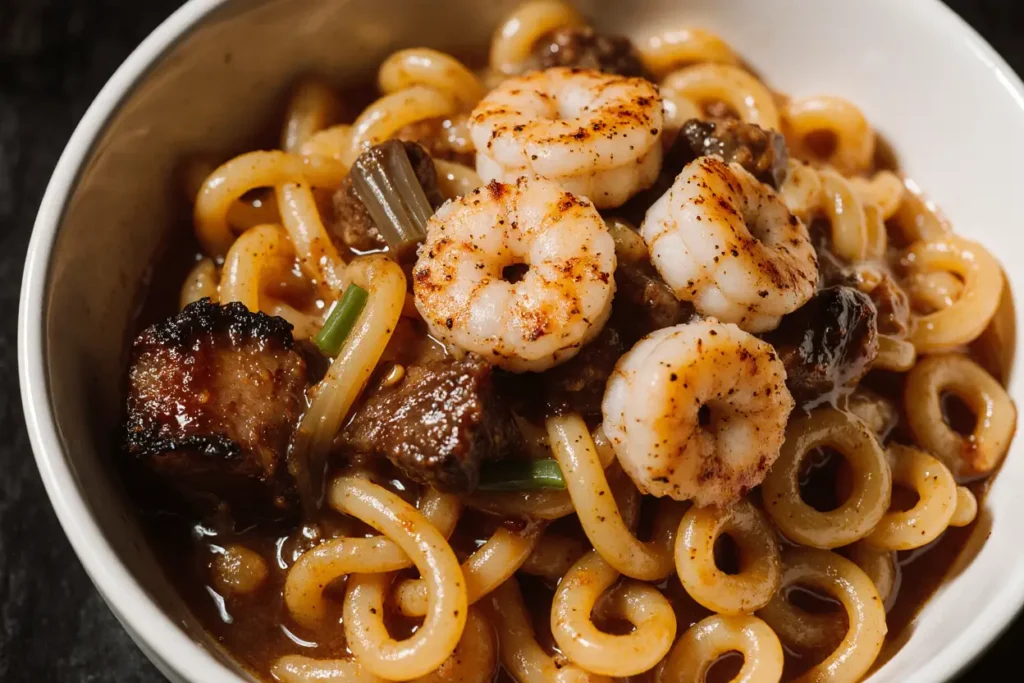
Storing Tips for the Recipe
This dish is best enjoyed immediately while the noodles maintain their ideal texture and the proteins remain tender. However, leftovers can be stored in the refrigerator for up to 3 days in airtight containers. Reheat gently in a large skillet over medium heat, adding a splash of broth or water to prevent sticking and restore moisture.
For meal prep enthusiasts, consider storing the components separately. Cooked proteins can be refrigerated for up to 4 days, while blanched vegetables and cooked noodles keep for 3 days. This allows you to quickly assemble fresh portions throughout the week.
Freezing isn’t recommended for this dish as the noodles and vegetables lose their desirable texture upon thawing. However, the seasoned raw proteins can be frozen separately for up to 3 months, making it easy to have the main components ready for quick assembly.
If you must store leftovers, slightly undercook the noodles initially so they don’t become mushy when reheated. Add fresh herbs and a squeeze of lemon juice when reheating to brighten flavors that may have dulled during storage.
Conclusion
This garlic butter steak and shrimp stir-fried noodles recipe proves that restaurant-quality surf and turf dishes are absolutely achievable in home kitchens. The description of flavors and textures – from the perfectly seared proteins to the aromatic garlic butter and tender-crisp vegetables – creates a dining experience that rivals expensive steakhouses at a fraction of the cost.
The beauty of this dish lies in its impressive presentation combined with surprisingly straightforward technique. In just 25 minutes, you can create a meal that looks and tastes like it took hours to prepare. The high-heat stir-fry method ensures every component maintains its ideal texture while the garlic butter ties everything together in harmonious perfection.
Whether you’re looking to impress dinner guests, treat your family to something special, or simply elevate your weeknight dinner routine, this recipe delivers consistent, spectacular results. The combination of premium proteins, fresh vegetables, and perfectly seasoned noodles creates a balanced meal that satisfies both nutritionally and culinarily.
Ready to transform your dinner table with this show-stopping dish? Fire up that wok this weekend and prepare to be amazed by what you can accomplish in your own kitchen. Share your results and personal variations in the comments below – we love seeing how home cooks make this recipe their own!
FAQs
Q: Can I use frozen shrimp for this recipe? A: Absolutely! Thaw frozen shrimp completely and pat them very dry before cooking. Frozen shrimp often work better than fresh for stir-fries as they hold their shape well and cook quickly without becoming rubbery.
Q: What’s the best cut of steak for stir-frying? A: Sirloin offers the best balance of flavor and tenderness for the price. Ribeye works beautifully if budget allows, while flank steak sliced against the grain is an economical alternative. Avoid thick cuts like filet mignon, which are better suited for other cooking methods.
Q: Can I make this dish gluten-free? A: Yes! Use rice noodles or certified gluten-free pasta, and substitute tamari for soy sauce. Check that your oyster sauce is gluten-free, or use mushroom sauce as an alternative.
Q: How do I prevent my stir-fry from becoming watery? A: Ensure all ingredients are properly dried before cooking, use high heat throughout, and don’t overcrowd the pan. Add sauce only in the final minute and avoid covering the pan, which traps steam and creates moisture.
Q: Can I prep ingredients ahead of time? A: Yes! Cut all vegetables and proteins up to 24 hours ahead and store separately in the refrigerator. Mix the sauce and cook noodles up to 6 hours in advance. Having everything prepped makes the actual cooking process incredibly fast and stress-free.


